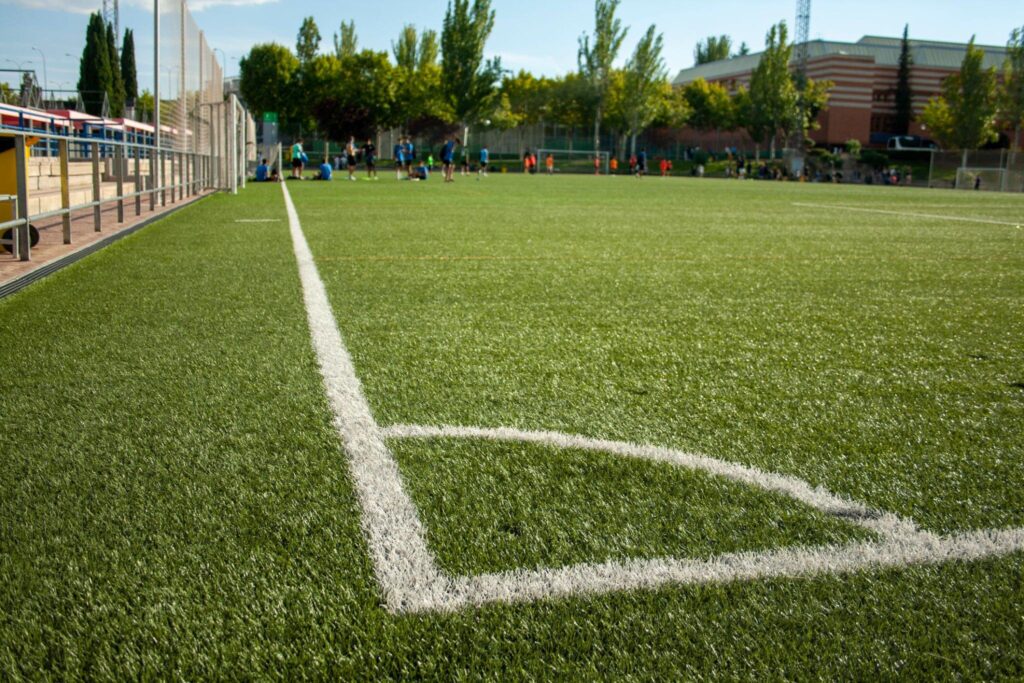If you’re torn between natural grass and artificial turf for your backyard or garden upgrade, this blog is for you. We’ll compare both options, weighing the pros and cons, including aesthetics, maintenance, performance, and durability, to help you make the right choice.
Let’s kick off with synthetic turf.
Pros of Artificial Turf
- Low Maintenance: One of the primary attractions of artificial turf is its minimal maintenance requirements. Unlike natural grass, watering, mowing, and pest control are unnecessary. It is a low-maintenance and time-saving option.
- Durability: Artificial turf is designed to withstand heavy foot traffic and harsh weather conditions without losing its lush appearance. It is made using polyethylene and polypropylene fibers with high resistance properties to fading and staining.
- Conservation of Resources: With growing concerns about water scarcity and environmental sustainability, artificial turf offers a water-efficient alternative to traditional grass.
- Versatility: You can install artificial grass anywhere indoors and outdoors, including rooftops, sports fields, commercial landscapes, or any other place where you want to create the green effect.
- Year-Round Usability: Astroturf withstands all seasons regardless of weather conditions. You can install it anywhere without the fear of losing its luster.
Cons of Artificial Turf
- Initial Cost: One of the major drawbacks of artificial turf is its upfront cost, which is comparatively higher than that of natural grass. Its material and installation are a little expensive, but it is not wrong to say that it is worth it in the long run.
- Heat Retention: Artificial turf absorbs and retains heat, especially in direct sunlight. It can result in higher surface temperatures than natural grass.
- Infill Concerns: Most artificial turf installations require infill materials such as sand or rubber pellets to provide stability and cushioning. However, there are concerns about the potential health and environmental impacts of certain infill materials like microplastic and rubber fills. You can address this problem using eco-friendly infills.
- Aesthetics: While modern artificial turf mimics the look and feel of natural grass more closely than ever before, some people still find it lacking authenticity. Its uniform look may not appeal to those who prefer originality.
Pros of Traditional Grass
- Natural Beauty: Natural grass appeals due to its natural look and unsymmetrical appearance. It creates an inviting outdoor space to breathe fresh and relax.
- Environmental Benefits: Natural grass provides numerous environmental benefits, including oxygen production, carbon sequestration, and soil erosion prevention. It improves air quality and contributes toward a healthy ecosystem.
- Cooling Effect: Unlike artificial turf, natural grass has a cooling effect on the surrounding environment through evapotranspiration. It reduces surface temperature and lowers the heat stress.
- Renewable Resource: Grass is a renewable resource that regenerates naturally through seed germination and vegetative growth.
- Customization Options: With various grass species and cultivars available, unlike artificial turf, you can customize its appearance.
Also Read: 3 Reasons Why Artificial Grass is Better than Natural Grass for Kids’ Play Areas
Cons of Traditional Grass
- High Maintenance: Natural grass requires regular maintenance and labor-intensive tasks, including washing, mowing, and pest control, such as mowing, watering, fertilizing, and pest control. It takes a lot of time, effort, and money.
- Water Usage: Grass lawns are notorious for their high water consumption. Excessive water usage for lawn maintenance consumes water and increases utility bills.
- Pesticide and Herbicide Use: To maintain its pristine appearance, you need to treat natural grass with pesticides and herbicides. These synthetic chemicals pose risks to humans and pets.
- Seasonal Limitations: Natural grass lawns are subject to seasonal growth, appearance, and usability variations. During dormant periods in winter or periods of drought in summer, grass may turn brown and thin out, losing its luster.
- Susceptibility to Damage: Natural grass is susceptible to damage from factors such as heavy foot traffic, pet waste, extreme weather events, and fungal diseases. Restoring natural grass will cost you a lot.
Contact Artificial Grass NYC For Artificial Turf Installation
After considering the advantages and disadvantages of natural and artificial grass. If you are inclined towards artificial turf installation, then Artificial Grass NYC is the perfect choice. We specialize in seamless AstroTurf installation. Our durable and visually appealing turf is made from top-notch materials and installed with eco-friendly infill, prioritizing environmental sustainability.
Contact us today for an artificial grass installation project.













